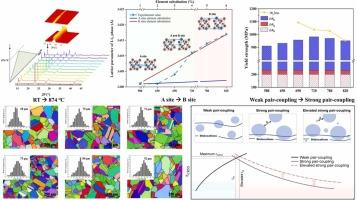Evolution of Ductile L12 Phase in (FeCoNi)86-Al7Ti7 High-Entropy Alloy Aging at Various Temperatures and Its Strengthening Mechanism
IF 5.8
2区 材料科学
Q2 CHEMISTRY, PHYSICAL
引用次数: 0
Abstract
Ductile participation with small lattice misfit against matrix has been a long-sought-after character in toughening alloys, and recently multicomponent intermetallic nanoparticle L12 phase was explored by compositional modification in FeCoNi-based alloys and reported its benefits on strength and ductility through 780 °C for 4 h aging treatment. However, the L12 (A3B: Ni3Al) evolution in (FeCoNi)86-Al7Ti7 at a wide range of aging temperatures still lacks of comprehensive investigations. Herein, a series of aging temperatures (580 °C, 650 °C, 690 °C, 720 °C, 780 °C, and 820 °C) were carried out based on the synchrotron in-situ variable temperature XRD of the alloy. Results showed that both the composition and morphology of the L12 phase are dramatically dependent on the aging temperatures. Specifically, with aging temperature increased from 580 °C to 820 °C, A sites preferentially incorporated by more Co and Fe gradually turn into B sites partially substituted by Fe and Ti in the L12 phase, together with its morphology transforming from spherical to cuboidal. Meanwhile, the hierarchical microstructure induced by the precipitates of the tiny L12 phase at the aging temperature of 780 °C compensated the size departure of the primary L12 phase against the critical size to enhance the strength by enhancing its dislocation storage capacity. These hierarchical L12 phases strengthen the strong pair-coupling mechanism, ultimately illustrating its excellent strength-ductility balance aging at 780 °C against other aging temperatures.

不同温度下老化的 (FeCoNi)86-Al7Ti7 高熵合金中韧性 L12 相的演变及其强化机制
与基体晶格错位小的韧性参与一直是增韧合金所追求的特性,最近通过成分改性在铁钴镍基合金中探索了多组分金属间纳米粒子 L12 相,并报道了其在 780 °C 4 小时时效处理中对强度和延展性的益处。然而,对于(FeCoNi)86-Al7Ti7 中的 L12(A3B:Ni3Al)在较宽的时效温度范围内的演化仍缺乏全面的研究。本文基于同步加速器原位变温 XRD 对合金进行了一系列老化温度(580 ℃、650 ℃、690 ℃、720 ℃、780 ℃ 和 820 ℃)的研究。结果表明,L12 相的成分和形态都与时效温度有很大关系。具体来说,随着时效温度从 580 ℃ 升高到 820 ℃,L12 相中由更多 Co 和铁优先结合的 A 位点逐渐转变为由铁和钛部分替代的 B 位点,其形态也从球形转变为立方体。同时,在 780 ℃ 的老化温度下,微小 L12 相的析出物所诱导的分层微观结构补偿了原生 L12 相的尺寸偏离临界尺寸的情况,从而通过提高其位错存储能力来增强强度。这些分层的 L12 相强化了强对偶机制,最终说明了在 780 °C 老化温度下与其他老化温度相比,该材料具有出色的强度-电导率平衡能力。
本文章由计算机程序翻译,如有差异,请以英文原文为准。
求助全文
约1分钟内获得全文
求助全文
来源期刊

Journal of Alloys and Compounds
工程技术-材料科学:综合
CiteScore
11.10
自引率
14.50%
发文量
5146
审稿时长
67 days
期刊介绍:
The Journal of Alloys and Compounds is intended to serve as an international medium for the publication of work on solid materials comprising compounds as well as alloys. Its great strength lies in the diversity of discipline which it encompasses, drawing together results from materials science, solid-state chemistry and physics.
 求助内容:
求助内容: 应助结果提醒方式:
应助结果提醒方式:


